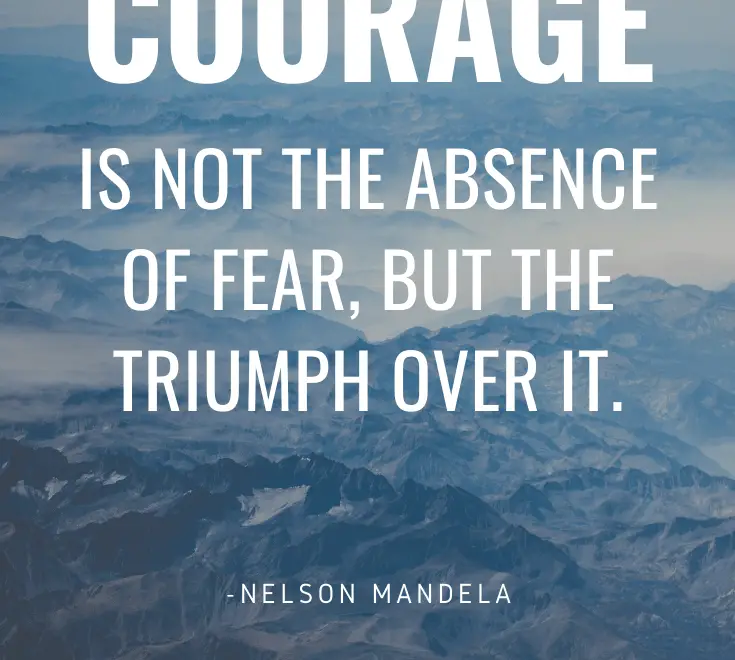This post may contain affiliate links. As an Amazon Associate I earn from qualifying purchases.
“Courage is not the absence of fear, but the triumph over it.” -Nelson Mandela
When I was a gymnast, I absolutely loved flipping. But eventually, as I progressed in the levels, some of the skills started to seem downright scary to me. I would balk. I would stand on the beam FOREVER and still not go backward. Some days, I would end up crying in the locker room. It took many months and several different approaches before I could finally work through my fears.
As a coach, I noticed that some gymnasts were fearful, as I had been. Others seemed to go for any skill I asked them to do. The “no fear” gymnasts are labeled by some coaches as courageous, while the fearful gymnasts were not. Is this accurate? Not necessarily.
What courage is not
While many people would call the fearless gymnasts courageous, lack of fear does not constitute courage. Courage is doing scary things despite your fear. A difficult skill may be easy for some gymnasts, but others might find that skill a bit daunting. The gymnast who performed the skill without any trepidation is not displaying as much courage as the gymnast who was nervous, but pushed through despite her fear.
Courage is NOT:
- Being fearless
- Never feeling afraid
- Possessing a lot of natural talent or skill
Now, this is not to say that someone who is a naturally talented athlete cannot also be courageous. But the natural talent alone is not a substitute for courage.
As Nelson Mandela stated, courage does NOT mean that a person is never afraid. The people who display the most courage are afraid a lot of the time! To be truly courageous, you need to take action even when fear exists.
What is courage?
Courage is being afraid, and moving forward despite the fear.
The only way to conquer fear is to take action. A person who is courageous finds a way to take action, even though they are afraid. Sounds easy, right?
Although it sounds easy, taking action on something scary is tough! First, it requires a change in mindset. Without realizing it, fear can make us feel like a victim of our circumstances. We need to leave this mentality behind before we can take a step forward.
To change this mindset, we need to think of the excuses we might be hiding behind due to fear. Does it feel like the coach is being too tough? The skill is too hard? The equipment doesn’t feel right? We need to address and dismiss any excuses in order to create our action plan.
Once we have determined what excuses might be getting in our way, it’s time to decide on an action plan to conquer our fear. First, name the goal: what are you afraid of that you would like to achieve? Next, keep the end goal in mind and determine what steps need to be taken to achieve it. Don’t be afraid to start really small and work up from there. Set a timeline for when each step should be completed. Finally, decide on a reward for once the goal is reached! For more on goal setting, read this post for some tips.

But I don’t feel courageous
But even with the best laid plan, fear can really be paralyzing! The important thing to remember is that when it feels like fear is stopping you, one small step is all you need to start getting past it. Doing the whole skill may be terrifying, but taking a small step toward that skill isn’t quite so bad.
For example, let’s say you are afraid to do your back handspring on the high beam. Start by doing your back handspring on a line on the floor. Make sure your hand and foot position is exactly as you would do it on the beam. Then set a number you will do each practice. Once that’s easy, move it to the low beam with mats stacked next to it. Gradually remove the mats until you’re doing it on the low beam alone. Then move up to a medium beam, and eventually the high beam. If your gym uses beam pads, you could use those as you move onto higher beams until you feel more secure, or you could stack mats under the beam and gradually remove the mats. It’s important to stay consistent and work on it every practice, gradually pushing yourself to move up to the next height. Before you know it, you’ll be doing it alone on the high beam!
For other skills, they can often be broken down into drills. If it’s vault that terrifies you, break the vault down into its component parts. Work on your run and hurdle. Make sure your steps are consistent. Work on vaults up to a mat stack and into the pit. Practice flipping from a standing position on the table. Do landing and air awareness drills. The more confident you are in each component of the skill, the more comfortable you will feel when it’s time to put it all together.
This framework holds true for anything else in life, too! Imagine that you’re afraid of public speaking. Once again, start small! Start by introducing yourself to someone new in a group setting, raising your hand in class or in a meeting, or taking part in a small group such as Toastmasters. Do one thing that pushes you just a little bit outside your comfort zone, then gradually stretch yourself a little further, and a little further.
How to help someone struggling with fear
If you’re a coach, and you have a gymnast who is challenged by fear, you can help them by using these principles. Encourage them to take a small step forward during their next practice, even if it means they are working on something much less difficult than what you think they should be working on. Find something they CAN do, and give them lots and lots of repetitions, until it’s easy for them. Then help them take the next step toward their scary skill.
If you’re a parent of a fearful gymnast, remember that it is not your job to be their coach. You can, however, help them by being encouraging, and remind them that you love them no matter what! You can also help them to remember that it’s ok to make a mistake. Your gymnast may be afraid of failure, even if she doesn’t say so, and she needs your support even more during this vulnerable time.
Similarly, if you have a teammate or friend who is afraid, be supportive to them! They may benefit from hearing a story from a time when you overcame a fear. Maybe you have a technical tip to help them with their consistency on a skill. But above all, they’ll be relieved to have your friendship, encouragement, and a shoulder to lean on.
Moving forward
If you’re interested in learning more about working through fear to achieve your goals, check out this book that I loved called Do It Scared, by Ruth Soukup. It comes with a fear archetype assessment, to help you look into what types of fear may be holding you back. Very interesting!
Fear is challenging, and some days the struggle can be almost overwhelming. Keep taking those tiny steps forward, though, and you’ll be well on your way to getting past it and achieving great things!
Need some affirmations to help you become more courageous? Click here to get your FREE Gymnast Affirmations!
Further Reading
How to Overcome Fear in Gymnastics

Kathleen says:
I may not be a gymnast, but your post is really helpful! Breaking down the steps to a very challenging task and taking it slow as you mentioned will make it easier and make you more confident! Yes, I agree courage is not the absence of fear, but moving forward despite being fearful. 🙂
admin says:
Glad you found it helpful!
April says:
Thank your for sharing! My word for the year is courage and it was great to read and gain more insight on it.
admin says:
Great word for the year and it is especially true during these times!
Andrea says:
Thank you for your perspective on Courage and fear. I dreamed of being a gymnast when I was you. I like how you used examples from your gymnastic life to illustrate your ideas. I look forward to reading more of your blogs.
admin says:
Thank you!